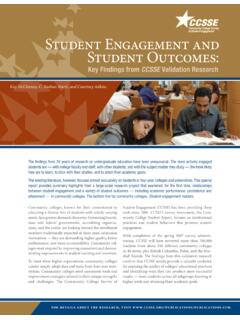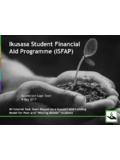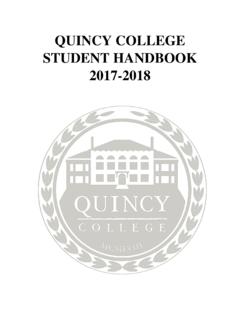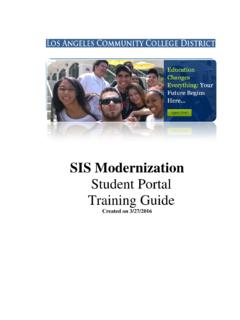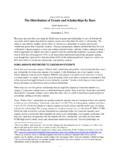Transcription of Show Me the Way - Community College Survey of Student ...
1 show Me the WayThe Power of Advising in Community Colleges2018 NATIONAL REPORTA cknowledgmentsIn 1972, Terry O Banion wrote, The purpose of academic advising is to help the Student choose a program of study. Forty-five years later, at a time when many colleges are working to transform their institutions with guided pathways, advisors are still asked to do the same thing: help students choose a program of study. However, even though the core function of advising is the same, the role of advisors continues to evolve and expand. As colleges around the country are redesigning the Student experience, job descriptions for advisors are changing. Advisors are being asked to outline each Student s sequence of courses, deliver post-assessment information, facilitate Student orientations, offer various types of guidance to students (individually and/or in group settings), work with each Student to create a personalized plan and continually review the plan to ensure that progress is made, outline information on resources and services the College provides, celebrate success points, assist with transfer and/or career planning, analyze Student retention data, and take appropriate steps to promote Student success.
2 Advisors are asked to do all of this and more, while simultaneously building a relationship with every Student they advise. More than ever before, advisors are critical to Student report is dedicated to all the advisors who work closely with students and help them complete their academic Center would also like to recognize the support of The Kresge Foundation for generously funding focus groups about advising at three colleges, allowing us to hear directly from students and advisors about this essential service. Evelyn N. Waiwaiole Executive Director Center for Community College Student EngagementAdvising: The Cornerstone of Student Support 1 students Who Are Advised Are More Engaged 4 Structure Matters 6 Content Matters 9 Intensity Matters 13A Different Advising Model: Student Athletes 14 College Examples: Advising in Action 16 Questions for Colleges as They Consider Advising 20 Published by the Center for Community College Student Engagement, The University of Texas at Austin 2018 Permission granted for unlimited copying with appropriate cite this report as follows: Center for Community College Student Engagement.
3 (2018). show me the way: The power of advising in Community colleges. Austin, TX: The University of Texas at Austin, College of Education, Department of Educational Leadership and Policy, Program in Higher Education : The Cornerstone of Student Support The Value of AdvisingAdvising is powerful because it attends to core elements of each Student s success: setting academic goals based on transfer and/or career interests, developing an academic plan to attain those goals, and staying on track until those goals are met. Each of these big-picture tasks encompasses dozens of smaller ones. These tasks include: Raising aspirations and setting goals. Advisors meet with students individually and/or in groups to help students explore their academic and career options and set career and academic goals. As part of this process, advisors show students paths they might not have considered such as transferring to earn a bachelor s degree or pursuing a career path with higher earning potential to help students improve their economic mobility.
4 Developing academic plans and registering for courses. Advisors help students develop detailed academic plans to attain their goals. And of course, they help students identify and register for the courses they need each term. Helping students help themselves. Advisors point students to a variety of supports including academic, financial, and social service resources that students can use to improve their College experience and opportunities for success. This effort to help students better engage with their coursework, peers, and instructors often starts with orientation and continues throughout the students years at the College . Focusing on the big picture. Advisors analyze Student retention data and use the findings to identify actions the College can take to improve overall Student outcomes. The multilayered benefits of advising are well established: Advisors help students make choices in a complex environment, often by explaining the costs and benefits of each available option, and they guide students to additional resources that will help them make good decisions.
5 These good decisions have benefits beyond putting students on track to meet their long-term goals. In addition, they help students feel welcome and engaged. Perhaps most important, they help students experience early successes meeting financial aid deadlines, enrolling in courses that advance their career goals, and so on that build their confidence. Over time, these early successes accumulate and give students a strong foundation for persevering and meeting the challenges of completing College . Advisors have a variety of titles, including academic advisors, career advisors, counselors, coaches, and mentors. This report uses the term advisor, and it incorporates all of these and faculty consistently report that advising is the most important Student service that colleges offer. Recent data from the Center for Community College Student Engagement suggest that students who receive more advising more time with advisors and more in-depth discussions in their sessions are more engaged.
6 For this semester, I didn t go to an advisor. I chose to skip, and I think I m sort of paying the price for it. Student The Power of Advising in Community Colleges 1 FOR MORE INFORMATION, VISIT Need for More AdvisingEven though the benefits of advising are well established, Center data indicate that not all students are getting everything they need. Among students who have been enrolled at their colleges for more than one semester, 78% report meeting with an advisor. Of those students , 47% report being very satisfied with their advising experience, 44% say they are somewhat satisfied, and 7% say they are not at all satisfied. If colleges consider the 22% of students who report not meeting with an advisor at all, along with the 44% who report doing so but being only somewhat satisfied and the 7% who say they are not at all satisfied, it becomes clear that many students need more when it comes to this important the evidence about the impact of advising, why aren t more students advised?
7 Why don t they all experience these critical points of early engagement that help them feel as if they belong at their College ? Why don t they all get the kind of advising that is proven to help students start accumulating successes from the moment they begin their College experience? This report aims to help colleges better understand advising, including how advising s structure, content, and intensity help shape the Student experience. While some colleges use digital platforms and tools to support advising, show Me the Way focuses on the human interactions of report includes returning Student data from the Community College Survey of Student Engagement (CCSSE), entering Student data from the Survey of Entering Student Engagement (SENSE), and faculty data from the Community College Faculty Survey of Student Engagement (CCFSSE).A Wise Investment in Advising The investment in 42 academic advisors resulted in an additional yearly cost of $2 million, but it more than paid for itself because the increased retention rate meant more revenue for the school.
8 Timothy M. Renick, President for Enrollment Management & Student Success; Vice Provost and ProfessorGeorgia State UniversityWhile Georgia State University (GSU) is a four-year institution, it is a public university that serves high percentages of low-income students , students of color, and first-generation students and does so with a shrinking pool of state funds. Yet GSU increased its graduation rate by more than 20 percentage points in a little more than a decade with great gains for students of color. In fact, Black and Hispanic students now have graduation rates that are comparable to or higher than those of White students . GSU made this progress while transforming its educational approach. Its reforms mirror the guided pathways approach now being implemented at Community colleges across the the first advising appointment, we try to get as much information from the Student as we can .. what their career goals are, what their major goals are, if they have plans to transfer because that is going to affect what program they re in.
9 We definitely have conversations about if they re working outside of school and their time management. ADVISOR 2 show Me the Way56%(N=28,835)Source: 2011 SENSE administration data 67% (N=27,854)Source: 2016 SENSE administration data Entering students 2011 Entering students 2016An advisor helped me set academic goals and create a plan for achieving themWhile the big-picture goals of advisors have remained consistent over time, colleges are now asking more of their advisors and of the advising process that it be more intrusive, more equitable, and more holistic. Around the country there are pockets of innovation, and evidence of this type of innovation is beginning to appear in Center Survey data. For example, in the 2011 SENSE administration, 56% of entering students said an advisor helped them set academic goals and create a plan for achieving them. In the 2016 administration, that figure rose 11 percentage points to 67%.Even as the role of the advisor becomes more complex, advisors continue to face the same long-standing challenges: high Student -to-advisor ratios; the need to advise the majority of students in a short time frame; and competing demands for students time, including work and , with the changing landscape of Community colleges, new challenges require advisors to have broader skill sets.
10 Advisors increasingly must, for example: Have in-depth conversations with students not only about degree plans and transfer opportunities, but also about current job markets, specific career opportunities and their earning potential, and career decisions based on those data points. Be intentional about avoiding bias by addressing each Student s challenges and helping each Student meet his or her new aspects of advising call upon colleges to consider whether additional training would help advisors better serve their Today: Progress and Challenges Our caseloads .. are still too large to really be able to follow up with students .. In a perfect world, we d have three times the amount of advisors. ADVISOR The Power of Advising in Community Colleges 3 FOR MORE INFORMATION, VISIT who report meeting with an advisor are more engaged across all CCSSE benchmarks than their peers who have not met with an advisor. This finding is not surprising, given that students and faculty consistently describe advising as very important.


